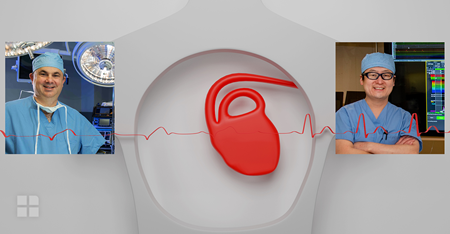I t’s well known that people delayed medical care during the COVID-19 pandemic. That is particularly problematic for patients with atrial fibrillation (AFib). “It’s an increasingly prevalent problem,” says Jamie Kim, MD, FACC, director of electrophysiology at CMC’s New England Heart & Vascular Institute (NEHVI). “We’ve had a lot of patients who delayed treatment and have much more severe AFib now.”
t’s well known that people delayed medical care during the COVID-19 pandemic. That is particularly problematic for patients with atrial fibrillation (AFib). “It’s an increasingly prevalent problem,” says Jamie Kim, MD, FACC, director of electrophysiology at CMC’s New England Heart & Vascular Institute (NEHVI). “We’ve had a lot of patients who delayed treatment and have much more severe AFib now.”
AFib is an irregular—and often rapid—heartbeat where the heart’s upper chambers (atria) beat out of sync with the lower chambers (ventricle). Patients don’t always have symptoms but they can feel palpitations, shortness of breath, light headed, weak, or chest pains. This arrhythmia affects the heart’s ability to pump blood and can lead to potentially life-threatening complications like blood clots, stroke, and heart failure.
There are a number of way to successfully manage or treat AFib, including medications and surgical interventions. “Over the past 20 years the movement has been to go with minimally invasive techniques, so catheter ablation has taken over more invasive treatment of AFib,” says Dr. Kim (shown on right).
Heartbeats are controlled by electrical currents. In patients experiencing AFib, these currents go haywire. A catheter ablation feeds a small probe through a catheter to the pulmonary vein of heart, where AFib most commonly begins. That energized probe either heats or freezes the faulty electrical pathways to try to prevent the AFib from starting. Ablation is a highly successful treatment for patients who go in and out of AFib.
However, “as patients live longer, or their AFib goes untreated,” says Dr. Kim, “the disease can progress to persistent atrial fibrillation. The longer someone is in AFib, the harder it is to bring them out of it. The heart starts to get used to it and, in long-standing persistent AFib, catheter ablation isn’t as successful.”
This is where NEHVI’s cardiac surgeons enter the picture. For decades, surgeons have treated AFib while performing open heart surgery for bypass or valve replacement. In that setting, the surgeon can ablate the wall of the heart, treating a much larger area. A new 2-step approach called Convergent takes the best of both worlds. Dr. David Caparrelli (shown on left), one of the cardiac surgeons at NEHVI ablates the posterior wall of the heart, using minimally invasive tools in the operating room. A few weeks later, Dr. Kim ablates the pulmonary vein in the electrophysiology (EP) lab.
“It’s like a fine point marker versus a highlighter or a paint brush,” explains Dr. Caparrelli. “I’m able to treat a much larger amount of tissue safely than in the EP lab, but I can’t get to all of the areas of the heart as Dr. Kim. When Dr. Kim sees patient back in clinic, he does a 3D map of electrical activity of the heart and completes ablation. It takes far less time than if he were to do it all himself and it’s better for the patient.”
In addition to the ablation, Dr. Caparrelli places a clip to close off a part of the heart called the left atrial appendage. The irregular heartbeat of AFib can cause blood to pool in the left atrial appendage, a small sac in the left atrium of the heart. This blood can form a clot and lead to a stroke. In fact, says Dr. Caparrelli, clots from the left atrial appendage are “responsible for about 90-percent of strokes in AFib patients. To adequately treat AFib of any kind, you want to control rhythm, but you also want to manage stroke risk by closing off the left atrial appendage.”
The results of the Convergent procedure are, so far, very promising. “It’s still not 100-percent,” says Dr. Kim, “but in patients with long-standing persistent AFib, about 67-percent still had normal rhythm one year out from the Convergent procedure.” Some patients may also be able to stop taking the daily blood thinner typically prescribed to AFib patients.
What makes the biggest difference for these patients is having the two teams—electrophysiology and cardiac surgery—work together. “We can treat patients that previously couldn’t have been treated as successfully by either of us individually,” says Dr. Caparrelli. “This is a hallmark of where this institution and the industry are going in terms of multidisciplinary collaboration.”